With its diverse landscapes and ecosystems, Mississippi is a haven for a wide array of bird species, including an impressive lineup of birds of prey.
These magnificent raptors have adapted to the state’s woodlands, wetlands, grasslands, and waterways, showcasing their remarkable hunting skills and aerial prowess.
From the iconic Bald Eagle soaring high above the Mississippi River to the stealthy Cooper’s Hawk hunting in the dense forests, the state offers a rich and varied habitat for these apex predators.
Whether you’re an avid birdwatcher, a wildlife enthusiast, or simply someone who appreciates the wonders of nature, Mississippi’s diverse collection of birds of prey provides ample opportunities for observation and appreciation of these awe-inspiring creatures in their natural environment.
18 Birds of Prey in Mississippi
Mississippi is home to various birds of prey or raptors, each adapted to its specific habitat and hunting preferences. Here are 18 birds of prey that can be found in Mississippi:
1. Red-tailed Hawk (Buteo jamaicensis)
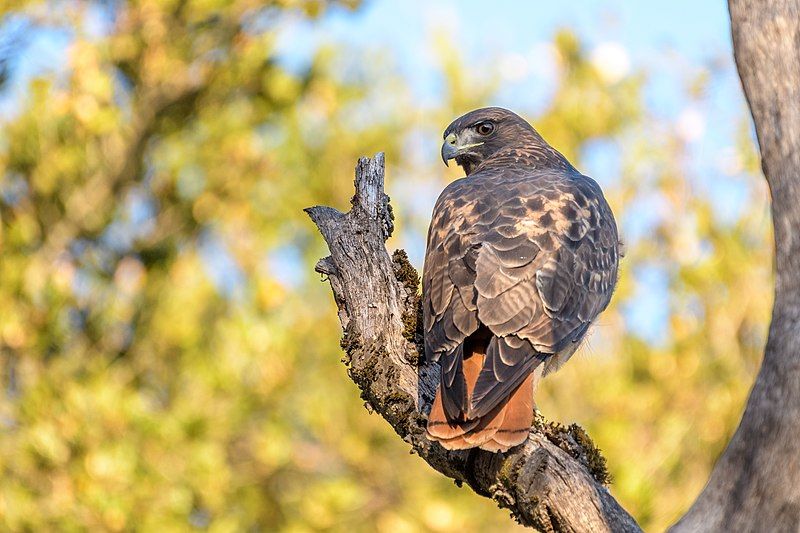
The Red-tailed Hawk, scientifically known as Buteo jamaicensis, is a majestic raptor native to North America. Recognizable by its striking red tail feathers, this bird of prey is a formidable hunter.
It boasts a wingspan of up to 56 inches (142 cm) and a body length of around 18-26 inches (46-66 cm). Red-tailed hawks primarily feed on rodents, birds, and occasionally reptiles, using their sharp talons and powerful beaks to capture and subdue their prey.
They are known for their impressive soaring abilities, often seen gliding effortlessly on updrafts as they search for food. These hawks are frequently found in various habitats, from open fields to forests, making them one of North America’s most widespread and adaptable raptors.
| Kingdom | Animalia |
| Phylum | Chordata |
| Clade | Dinosauria |
| Class | Aves |
| Order | Accipitriformes |
| Family | Accipitridae |
| Genus | Buteo |
| Species | B. jamaicensis |
2. Red-shouldered Hawk (Buteo lineatus)
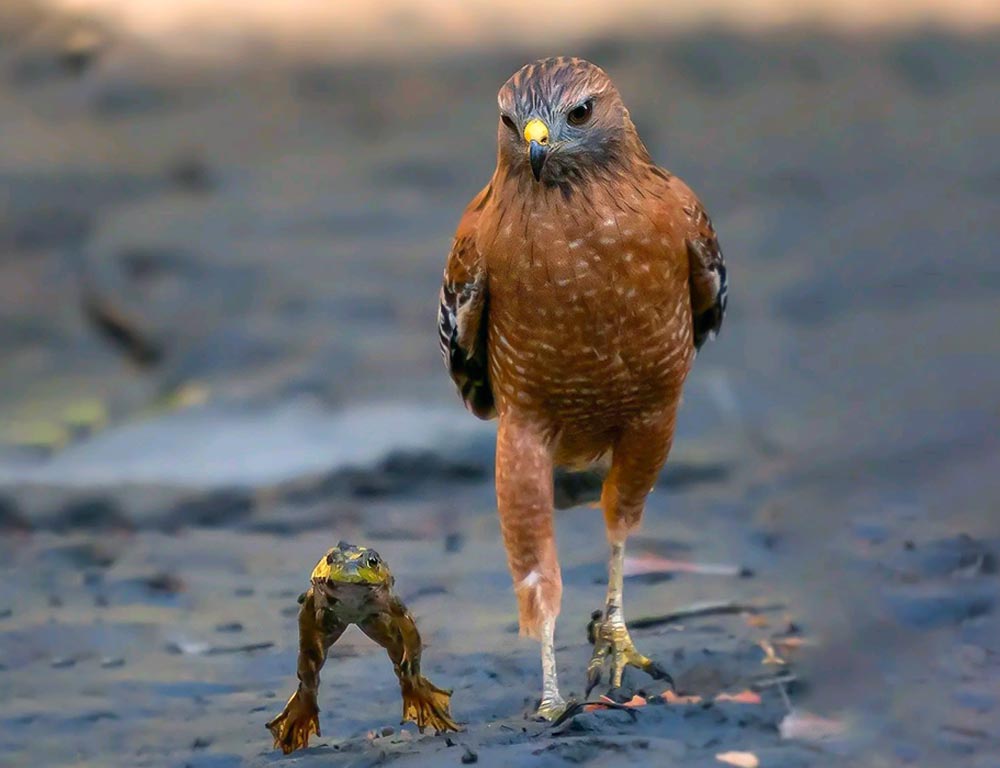
| Kingdom | Animalia |
| Phylum | Chordata |
| Class | Aves |
| Order | Accipitriformes |
| Family | Accipitridae |
| Genus | Buteo |
| Species | B. lineatus |
3. Cooper’s Hawk (Accipiter cooperii)
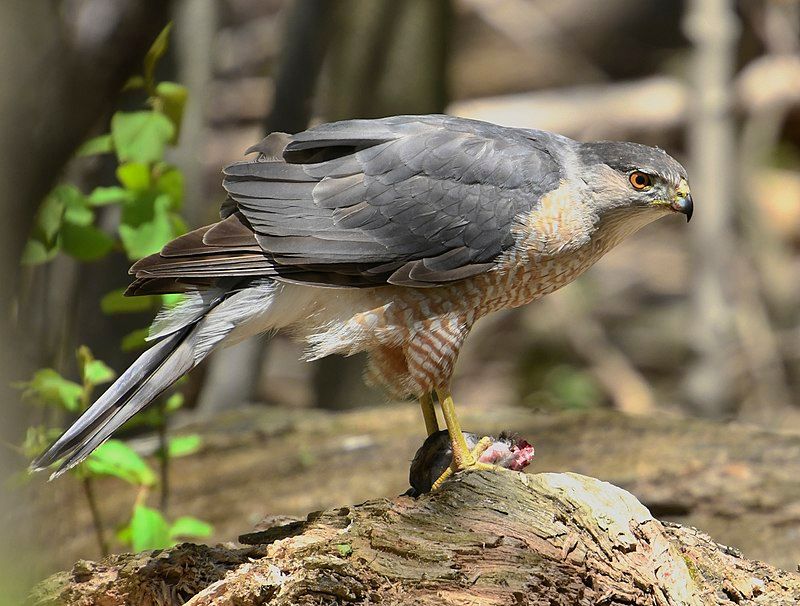
Scientifically known as Accipiter cooperii, the Cooper’s Hawk is a medium-sized bird of prey found in North America. These raptors have a wingspan of approximately 24-36 inches (61-91 cm) and a length of 14-20 inches (36-51 cm).
They are known for their striking blue-gray plumage, rounded wings, and long tails. Cooper’s Hawks are agile hunters, preying on birds and small mammals, often ambushing their prey in wooded areas or near bird feeders.
They are considered “bird hawks” because they prefer avian prey. These hawks are skilled fliers, carefully navigating through dense forests to catch their quarry.
| Kingdom | Animalia |
| Phylum | Chordata |
| Class | Aves |
| Order | Accipitriformes |
| Family | Accipitridae |
| Genus | Accipiter |
| Species | A. cooperii |
4. Sharp-shinned Hawk (Accipiter striatus)
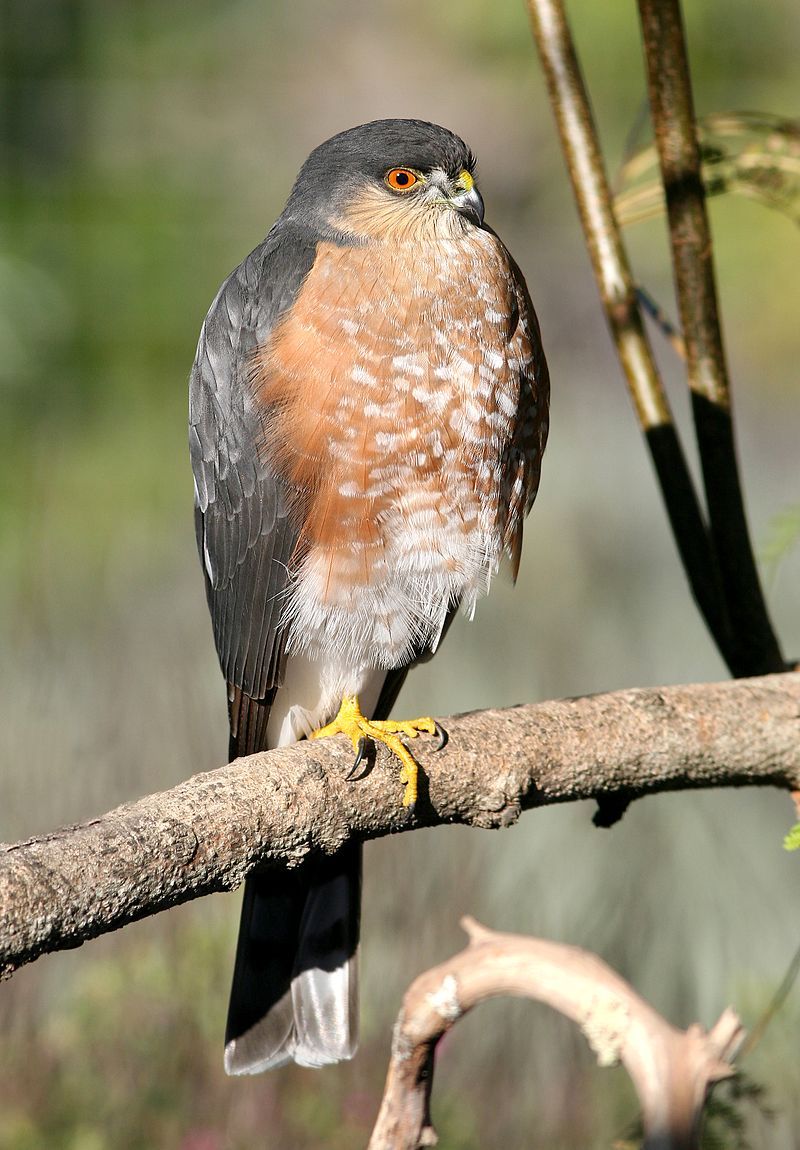
The Sharp-shinned Hawk, scientifically named Accipiter striatus, is a smaller, forest-dwelling raptor. They possess a wingspan of 22-26 inches (56-66 cm) and a length of 9-13 inches (23-33 cm).
Their plumage resembles that of Cooper’s Hawks, with blue-gray coloring and barred underparts. Sharp-shinned Hawks are known for their remarkable speed and agility, enabling them to capture small birds in flight.
They primarily feed on songbirds, making them skilled bird hunters. Their small size and quick movements make them challenging to spot in dense woodlands, where they often hunt.
| Kingdom | Animalia |
| Phylum | Chordata |
| Class | Aves |
| Order | Accipitriformes |
| Family | Accipitridae |
| Genus | Accipiter |
| Species | A. striatus |
5. Bald Eagle (Haliaeetus leucocephalus)

The Bald Eagle, scientifically called Haliaeetus leucocephalus, is an iconic bird of prey and the national symbol of the United States. These majestic eagles have a wingspan ranging from 6 to 7 feet (183-213 cm) and can reach lengths of 28-40 inches (71-102 cm).
Known for their distinctive white head and tail feathers, they have a dark brown body and yellow beak. Bald Eagles are opportunistic hunters and scavengers, feeding on fish, waterfowl, and carrion.
They are often associated with large bodies of water, where they use their powerful talons to snatch fish from the surface. Bald Eagles are known for their impressive aerial displays during courtship and can nest in tall trees near water sources.
| Kingdom | Animalia |
| Phylum | Chordata |
| Class | Aves |
| Order | Accipitriformes |
| Family | Accipitridae |
| Genus | Haliaeetus |
| Species | H. leucocephalus |
6. American Kestrel (Falco sparverius)
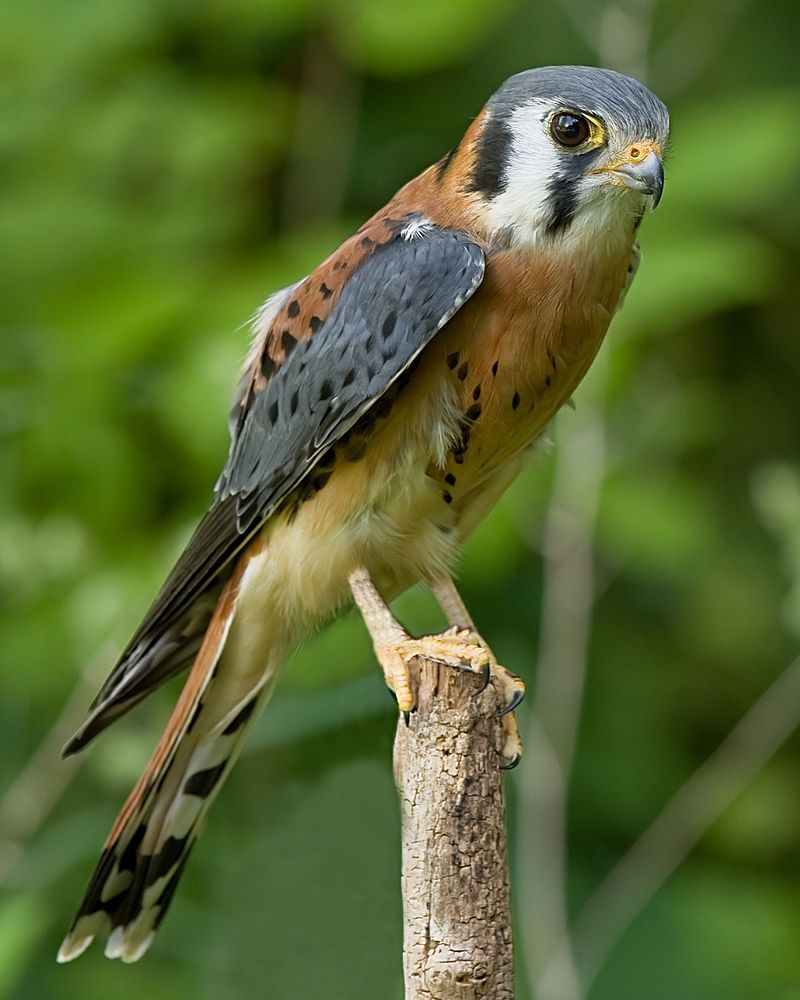
Scientifically named Falco sparverius, the American Kestrel is North America’s smallest falcon, measuring around 8-12 inches (20-31 cm) in length and possessing a wingspan of 20-24 inches (51-61 cm).
These colorful birds are sexually dimorphic, with males displaying vibrant blue-gray plumage and females featuring reddish-brown feathers.
American Kestrels are known for their hover-hunting technique, hovering in the air while scanning for insects, small mammals, and birds.
They are often found in open habitats, including grasslands, fields, and urban areas. These kestrels are agile hunters, using their sharp beaks and talons to capture prey.
| Kingdom | Animalia |
| Phylum | Chordata |
| Class | Aves |
| Order | Falconiformes |
| Family | Falconidae |
| Genus | Falco |
| Species | F. sparverius |
7. Broad-winged Hawk (Buteo platypterus)
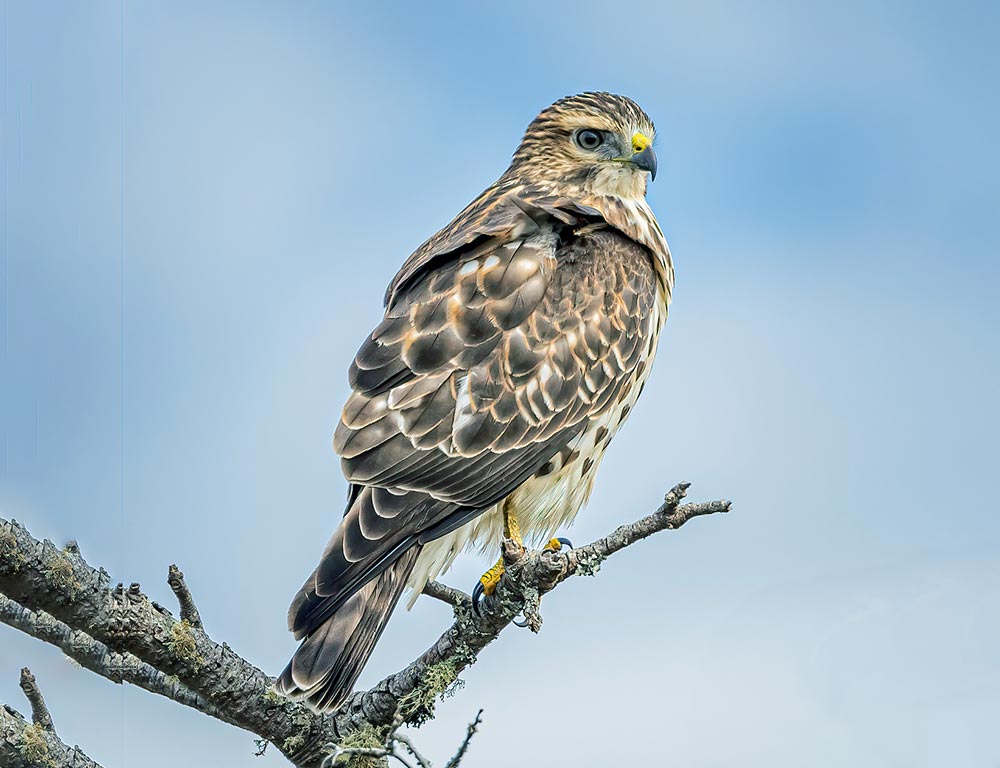
The Broad-winged Hawk, scientifically called Buteo platypterus, is a medium-sized hawk found in North America. These raptors have a wingspan of approximately 31-39 inches (79-99 cm) and a length of 13-17 inches (33-43 cm).
They are characterized by their broad wings and reddish-brown plumage with a distinctive dark belly band.
Broad-winged Hawks are known for their migratory behavior, traveling in flocks known as “kettles” during migration. They primarily feed on small mammals, amphibians, and reptiles, often hunting in dense forests and wooded areas.
| Kingdom | Animalia |
| Phylum | Chordata |
| Class | Aves |
| Order | Accipitriformes |
| Family | Accipitridae |
| Genus | Buteo |
| Species | B. platypterus |
8. Osprey (Pandion haliaetus)
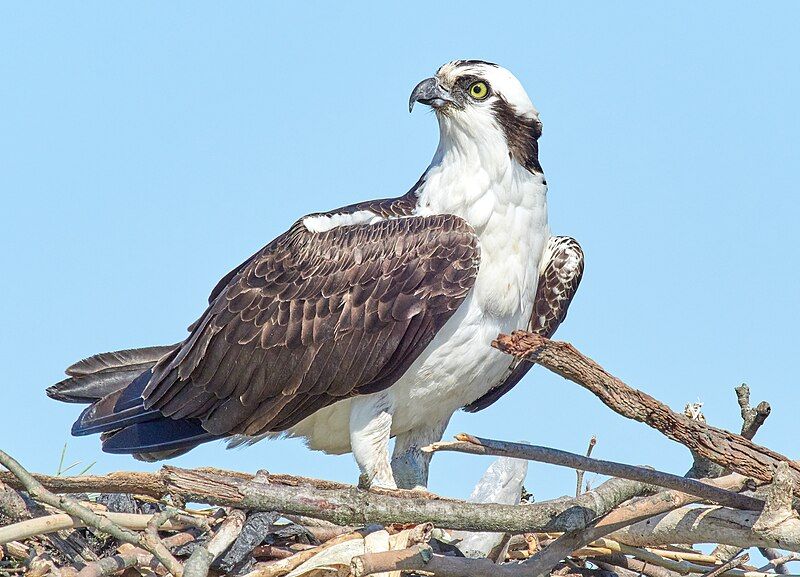
| Kingdom | Animalia |
| Phylum | Chordata |
| Class | Aves |
| Order | Accipitriformes |
| Family | Pandionidae |
| Genus | Pandion |
| Species | P. haliaetus |
9. Great Horned Owl (Bubo virginianus):
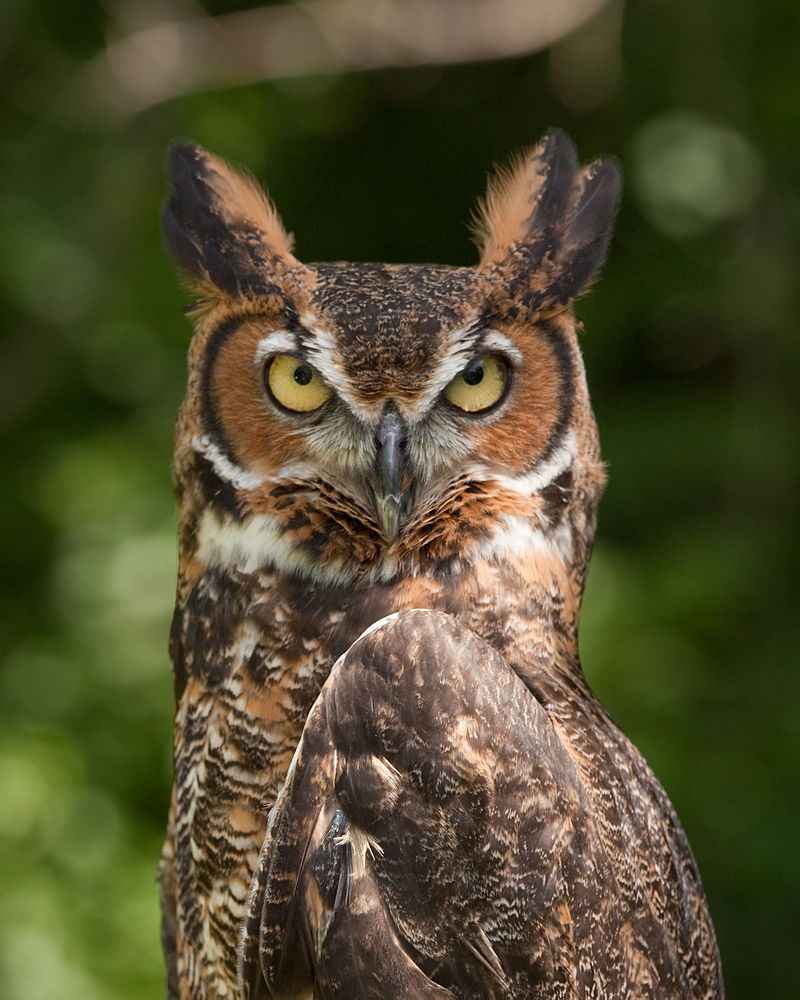
Scientifically known as Bubo virginianus, the Great Horned Owl is a formidable and adaptable raptor found throughout North and South America.
These owls are known for their distinctive “horns” or tufts of feathers on their head, which are not actually ears but serve to enhance their camouflage.
With a wingspan of around 36-60 inches (91-152 cm) and a length of 18-25 inches (46-64 cm), they are one of the largest owl species.
Great Horned Owls are powerful hunters, preying on various animals, including mammals, birds, and even skunks. Their excellent night vision and silent flight make them formidable nocturnal predators.
| Kingdom | Animalia |
| Phylum | Chordata |
| Class | Aves |
| Order | Strigiformes |
| Family | Strigidae |
| Genus | Bubo |
| Species | B. virginianus |
10. Barn Owl (Tyto alba)
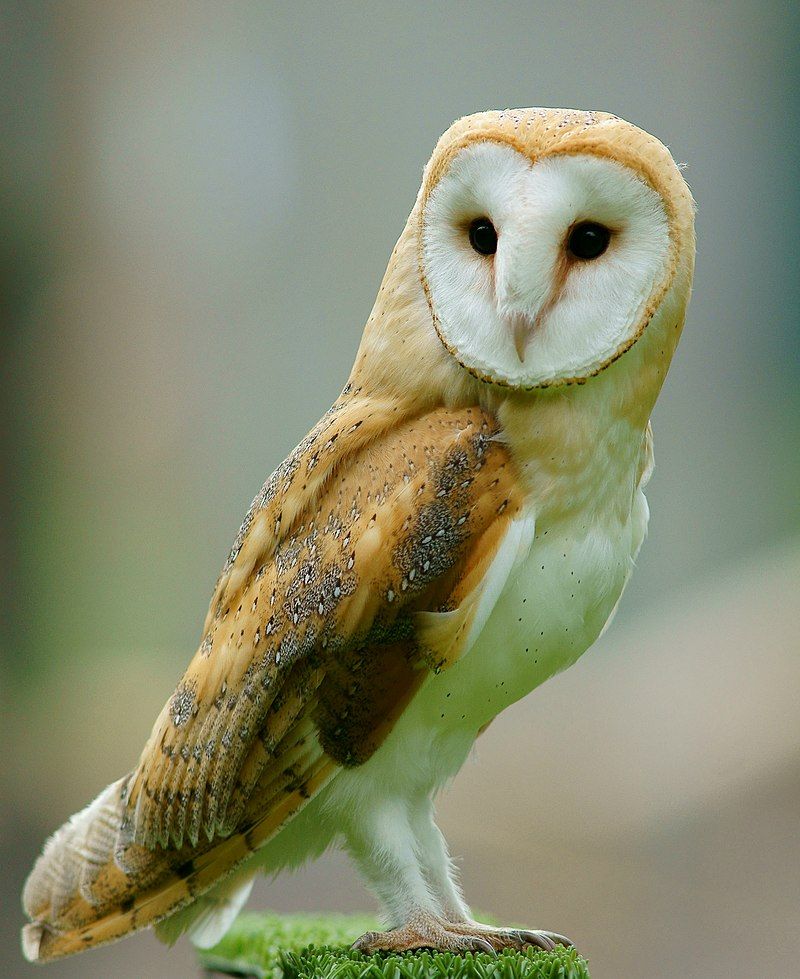
The Barn Owl, scientifically named Tyto alba, is known for its heart-shaped facial disc and eerie screeching calls. These owls are pale in color, with golden-brown to white plumage.
They have a wingspan of about 42-43 inches (107-110 cm) and a body length of 12-15 inches (31-39 cm). Barn Owls are efficient hunters of rodents and small mammals, using their keen hearing to locate prey in complete darkness. They often nest in barns, old buildings, and hollow trees.
| Kingdom | Animalia |
| Phylum | Chordata |
| Class | Aves |
| Order | Strigiformes |
| Family | Tytonidae |
| Genus | Tyto |
| Species | T. alba |
11. Turkey Vulture (Cathartes aura)
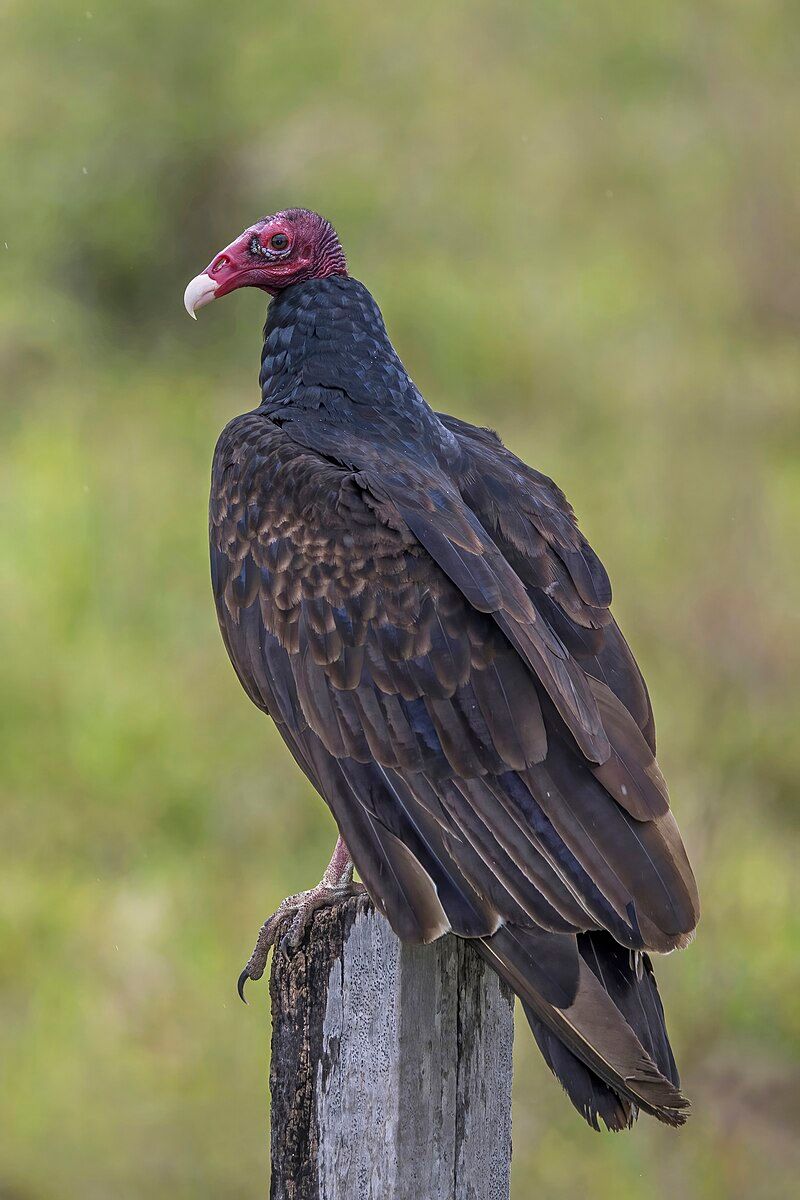
Scientifically referred to as Cathartes aura, the Turkey Vulture is a scavenging bird found throughout the Americas.
Recognizable by their bald red head and dark plumage, these vultures have wingspans of approximately 63-72 inches (160-183 cm) and measure 25-32 inches (64-81 cm) in length.
Turkey Vultures are carrion feeders, primarily consuming dead animals. They rely on their highly developed sense of smell to locate decaying carcasses.
These birds play a vital role in cleaning the environment by helping recycle nutrients from decomposing organic matter.
| Kingdom | Animalia |
| Phylum | Chordata |
| Class | Aves |
| Order | Accipitriformes |
| Family | Cathartidae |
| Genus | Cathartes |
| Species | C. aura |
12. Barred Owl (Strix varia)
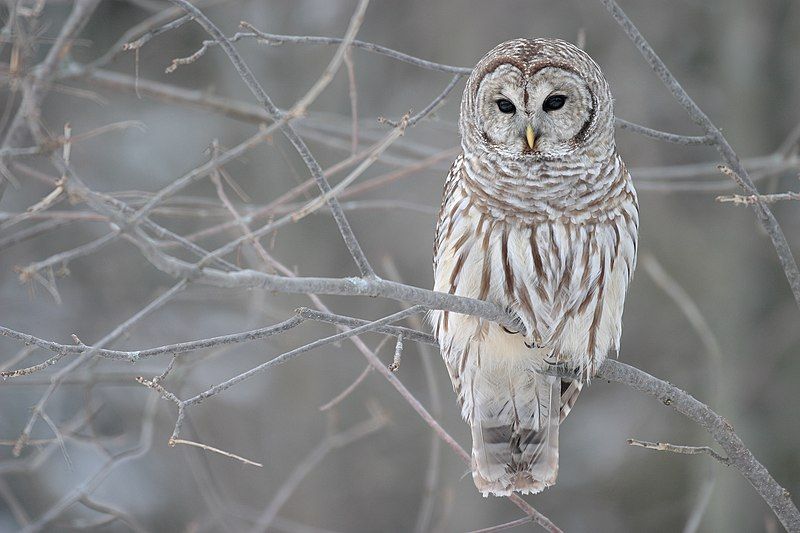
The Barred Owl, scientifically known as Strix varia, is a medium-sized owl native to North America. These owls have brownish-gray plumage with distinctive horizontal barring on their chest.
They possess a wingspan of approximately 38-50 inches (97-127 cm) and a length of 16-25 inches (41-64 cm). Barred Owls are known for their hooting calls that sound like “Who cooks for you?
Who cooks for you all?” They are skilled hunters, preying on various animals, including small mammals, birds, and amphibians. Barred Owls are often found in dense, wooded habitats near water sources, where they roost and nest in tree hollows.
| Kingdom | Animalia |
| Phylum | Chordata |
| Class | Aves |
| Order | Strigiformes |
| Family | Strigidae |
| Genus | Strix |
| Species | S. varia |
13. Eastern Screech Owl (Megascops asio)
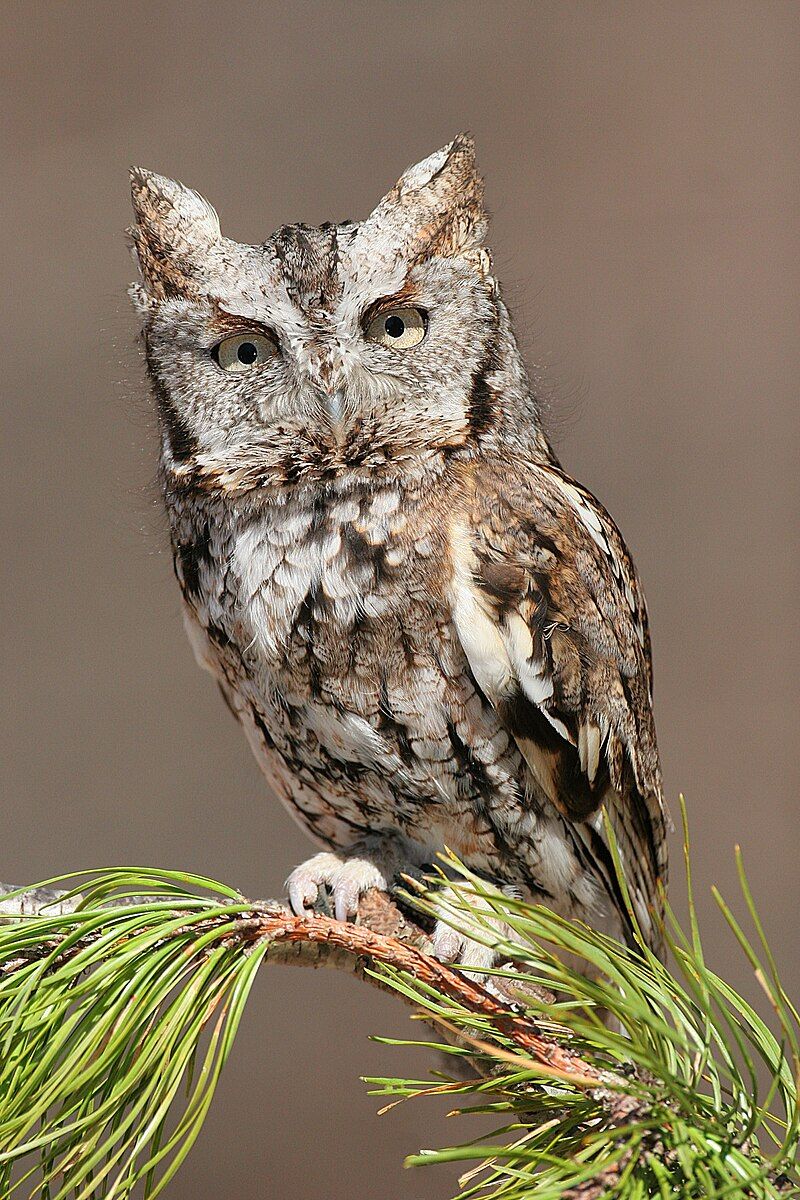
Scientifically referred to as Megascops asio, the Eastern Screech Owl is a small, nocturnal owl native to eastern North America. They measure around 6-10 inches (15-25 cm) in length and have a wingspan of 18-24 inches (46-61 cm).
Eastern Screech Owls come in two color morphs: red and gray. They are named for their distinctive trill-like calls, which can sound like a horse whinnying.
These owls primarily feed on insects, small mammals, and birds. They are cavity-nesting birds, often using abandoned woodpecker holes or nesting boxes as their homes.
| Kingdom | Animalia |
| Phylum | Chordata |
| Class | Aves |
| Order | Strigiformes |
| Family | Strigidae |
| Genus | Megascops |
| Species | M. asio |
14. Short-eared Owl (Asio flammeus)
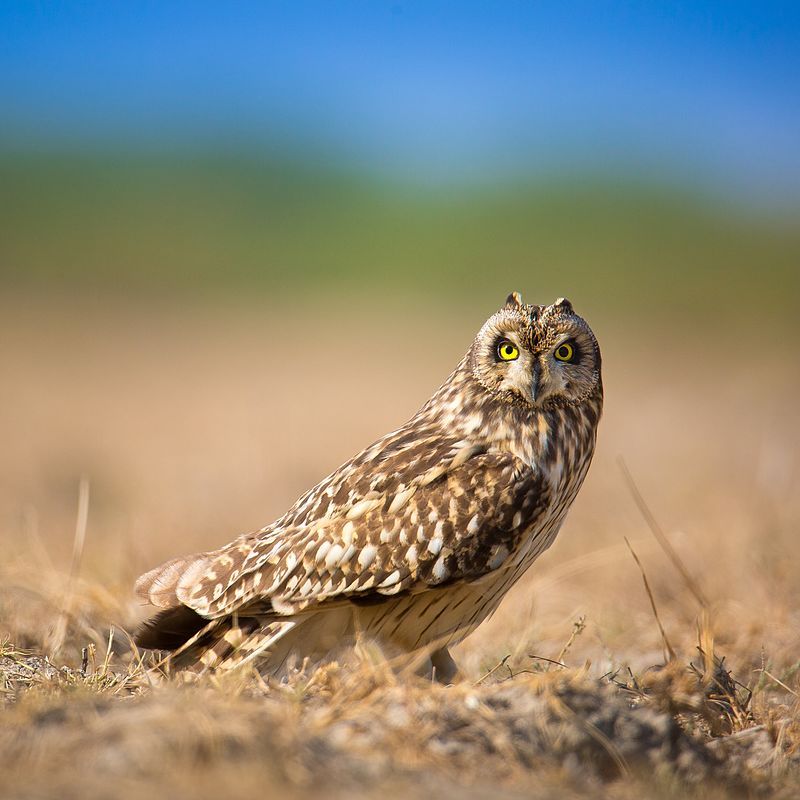
| Kingdom | Animalia |
| Phylum | Chordata |
| Class | Aves |
| Order | Strigiformes |
| Family | Strigidae |
| Genus | Asio |
| Species | A. flammeus |
15. Black Vulture (Coragyps atratus)
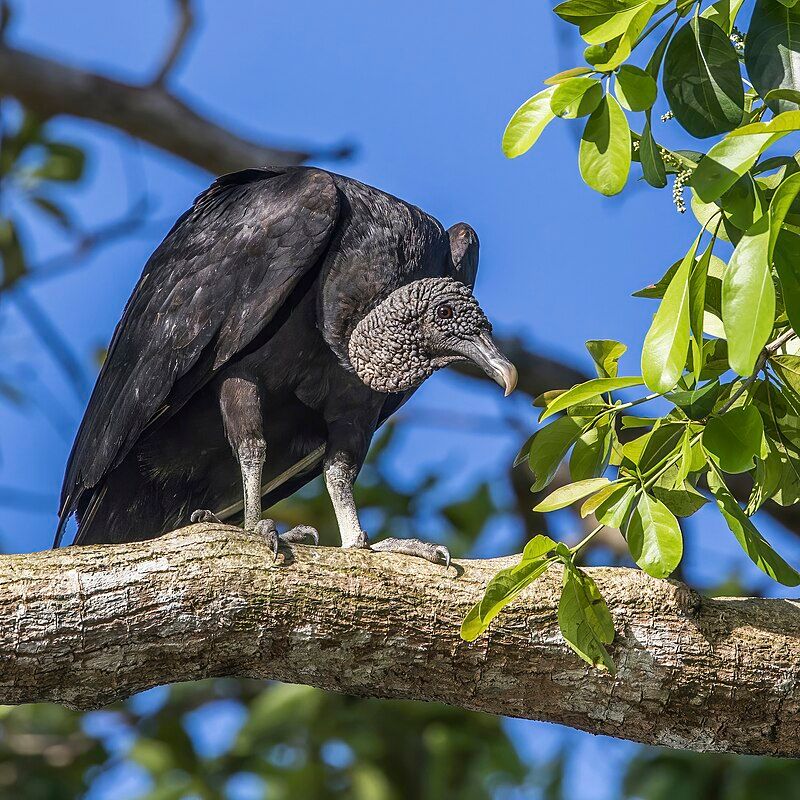
Scientifically known as Coragyps atratus, the Black Vulture is a scavenging bird of prey found in the Americas. These vultures are characterized by their entirely black plumage and bald heads, which starkly contrast to the red-headed turkey vulture.
With a wingspan of about 54-60 inches (137-152 cm) and a length of 24-27 inches (61-69 cm), Black Vultures are robust fliers and are often seen soaring in groups.
They primarily feed on carrion, using their keen eyesight and strong beaks to locate and consume dead animals.
Black Vultures play a vital ecological role by helping to clean up the environment and prevent the spread of disease by disposing of carcasses.
| Kingdom | Animalia |
| Phylum | Chordata |
| Class | Aves |
| Order | Accipitriformes |
| Family | Cathartidae |
| Genus | Coragyps |
| Species | C. atratus |
16. Peregrine Falcon (Falco peregrinus)
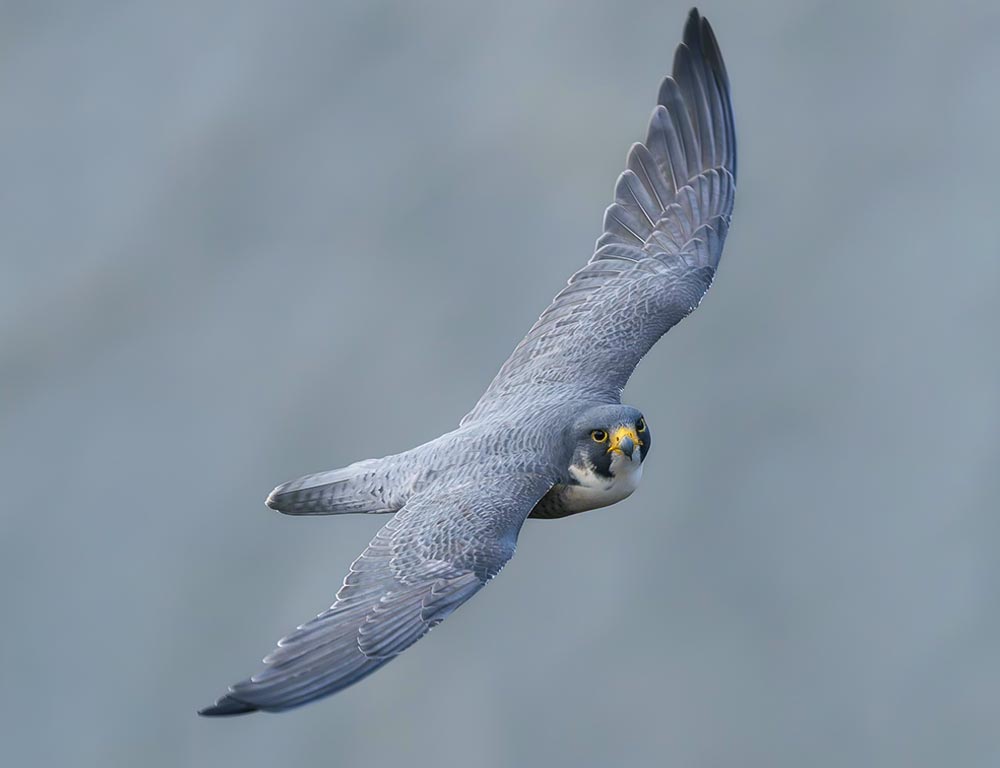
The Peregrine Falcon, scientifically named Falco peregrinus, is a globally distributed raptor known for its incredible speed and aerial prowess.
With a wingspan ranging from 38 to 44 inches (97-112 cm) and a length of 13-23 inches (34-58 cm), Peregrine Falcons are among the fastest animals on Earth, capable of reaching speeds over 240 miles per hour (386 km/h) during stoop dives.
They have distinctive blue-gray plumage with black markings on their head and wings. Peregrine Falcons primarily prey on other birds, striking them in mid-air with incredible precision.
These falcons have made a remarkable recovery from the brink of extinction due to the banning of the pesticide DDT and dedicated conservation efforts.
| Kingdom | Animalia |
| Phylum | Chordata |
| Class | Aves |
| Order | Falconiformes |
| Family | Falconidae |
| Genus | Falco |
| Species | F. peregrinus |
17. Ferruginous Hawk (Buteo regalis)
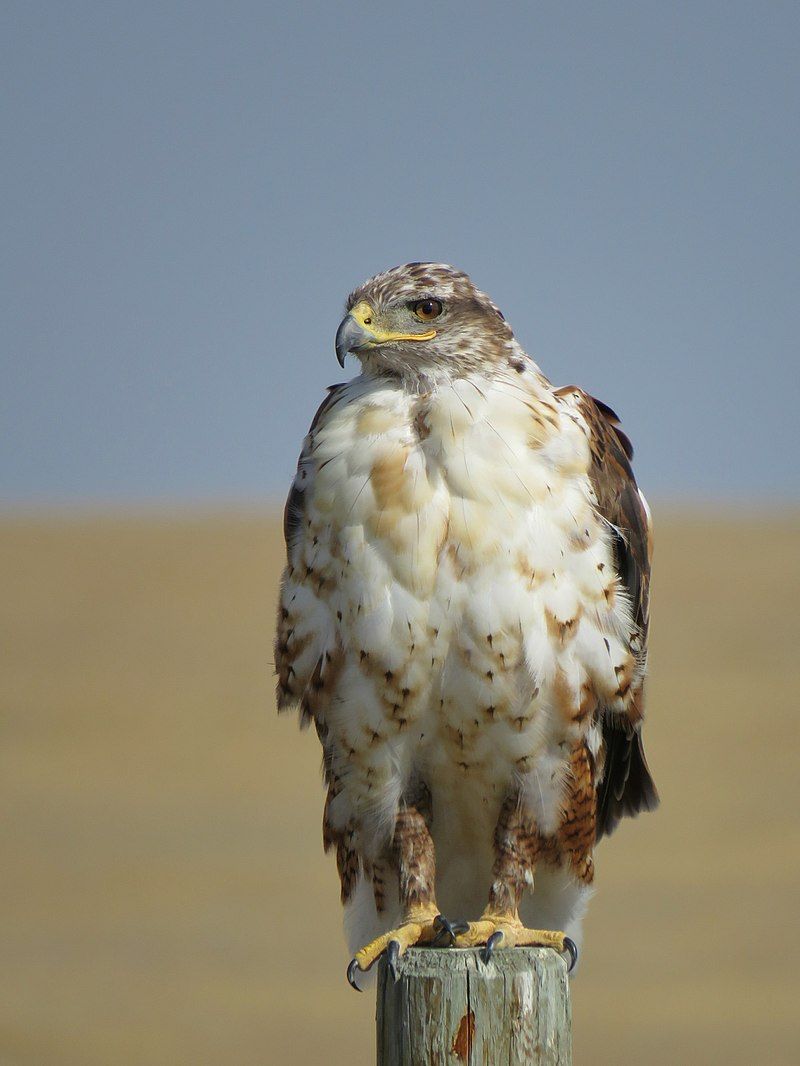
Scientifically known as Buteo regalis, the Ferruginous Hawk is a large and striking raptor found in North America. These hawks have a wingspan of 45-60 inches (114-152 cm) and a length of 20-27 inches (51-69 cm).
They are known for their unique pale plumage, which ranges from white to rusty red on their underparts, and their distinctive facial markings.
Ferruginous Hawks primarily feed on small mammals, particularly ground squirrels, and prairie dogs, which they capture with their powerful talons.
They are often associated with open grasslands and arid regions where these prey species are abundant. Conservation efforts are crucial to protect their habitats and ensure their survival.
| Kingdom | Animalia |
| Phylum | Chordata |
| Class | Aves |
| Order | Accipitriformes |
| Family | Accipitridae |
| Genus | Buteo |
| Species | B. regalis |
18. Harrier (Circus spp.)
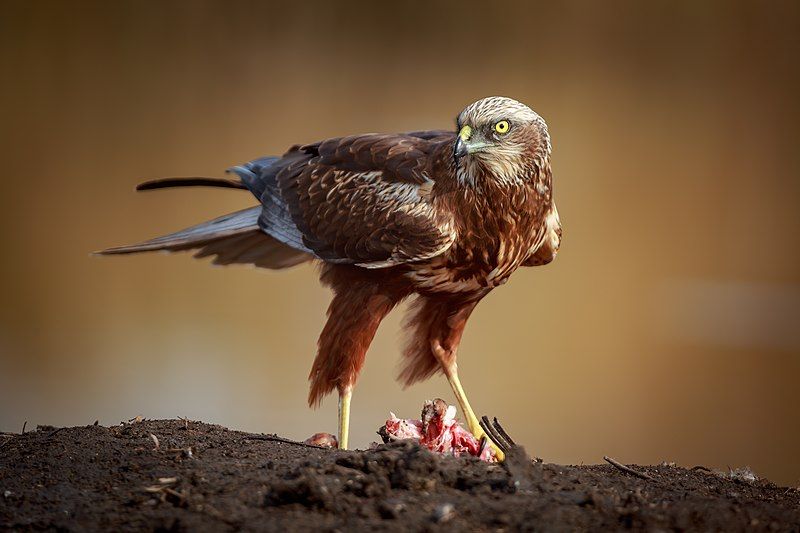
Harriers belong to the genus Circus, and several species are distributed worldwide. They are known for their distinctive behavior of hunting low over open areas, including wetlands, grasslands, and marshes.
These raptors have long wings and tails, enabling them to glide gracefully and efficiently over their preferred habitats. Harriers are characterized by their owl-like facial disks and keen eyesight, which they use to spot small mammals, birds, and reptiles.
Northern Harriers (Circus cyaneus) are commonly found in North America, while the Western Marsh Harrier (Circus aeruginosus) is widespread in Europe.
Harriers are often observed flying low and with their wings held in a V-shape as they search for prey.
| Kingdom | Animalia |
| Phylum | Chordata |
| Class | Aves |
| Order | Accipitriformes |
| Family | Accipitridae |
| Genus | Circus |
Conclusion
Birds of prey play a vital role in the ecosystem of Mississippi. The state’s diverse habitat provides a suitable environment for these majestic creatures to hunt, breed, and thrive.
From the large and powerful bald eagles to the agile and swift peregrine falcons, Mississippi is home to a wide variety of birds of prey that serve as important indicators of the ecosystem’s overall health.
Conservation efforts, such as establishing wildlife refuges and restoring habitats, have helped protect and promote the population of these magnificent birds.
However, challenges such as habitat loss, pollution, and climate change still pose threats to their survival.
It is crucial to continue prioritizing efforts to mitigate these threats and ensure the long-term survival of birds of prey in Mississippi to preserve the rich biodiversity and balance of the state’s natural landscape.